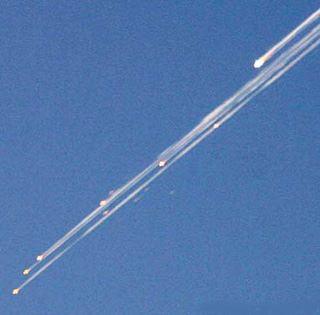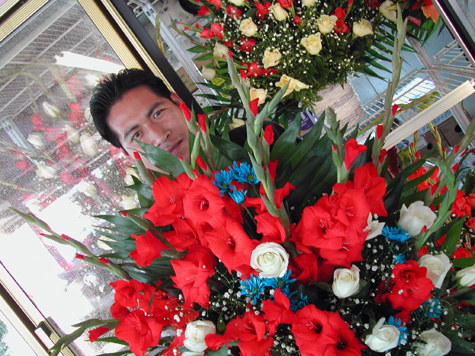Human Flower Project
With Flowers for the Columbia
A national tragedy revealed the human flower instinct.

The space shuttle Columbia, February 1, 2003
Photo: by Dr. Scott Lieberman, via AP
Six years ago today, we were driving to Houston on the Lunar New Year, fired up about interviewing some of the city’s Vietnamese, Chinese and Japanese residents about floral traditions of the “spring festival.” Breezing down Highway 71, we clicked on the radio and heard the news – something had gone very wrong with the space shuttle. Still-early reports suggested that the Columbia had been damaged re-entering the Earth’s atmosphere and broken apart over East Texas.
As we approached the Harris County line the worst was confirmed. The Columbia had exploded. All seven crew members were dead.
The news was haunting, especially for those of us who’d grown up during the “space race.” We could still remember sitting excitedly in a tiny chair in the school gym to watch Alan Shepherd lift-off in Freedom 7, May 5, 1961. The whole school watched this unbelievable event on a black and white television and cheered when the rocket sparked and heaved into flight.
But this was February 1, 2003. We’d hadn’t even been aware that the Columbia was orbiting Earth, on its 28th mission.
In a daze, we headed to Fannin Street, the flower district of Houston. Clustered around the 4800 block (intersection of Fannin and Rosedale) are half a dozen big flower shops – the rough kind, with open sides, long wet tables and pots and baskets lined along the sidewalk. This area is just north of Houston’s hospital district, and close to 59, a major thoroughfare through center city.

Tony Mendoza of Rosewood Flowers, Houston, Texas, February 1, 2003
Photo: Human Flower Project
At Rosewood Flowers things were bustling. Asian customers were buying orchids, red gladioli and branches of forsythia (reminiscent of bong mai – the lucky plant among Vietnamese Houstonians celebrating Tet). We also spotted Tony Mendoza intently arranging white roses, red glads, and daisy chrysanthemums dyed bright blue – one bouquet after another. Mendoza said that as soon as the news broke about the Columbia, people had come down to Fannin Street. They wanted red-white-and-blue flowers to deliver to NASA’s Johnson Space Center.
What a strange instinct, to line up bouquets outside a fortress of science and technology. Alongside the ancient lunar new year traditions, passed on through generations, here was something else, something contemporary. Reflexively, people were responding to a national tragedy with flowers, making an old expression of sympathy new. For us, February 1, 2003 marked a giant leap forward in the human flower project.
Today we remember Tony Mendoza and the Columbia’s crew, a bouquet of human skill and courage.

In a ‘flying’ pose for their traditional portrait, the crew aboard the Space Shuttle Columbia: in red (l-r) Kalpana Chawla, Rick D. Husband, Laurel Blair Salton Clark, Ilan Ramon; in blue (l-r) David Brown, William McCool, Michael Anderson.
Photo: NASA
Comments
Thank you for bringing this to our attention.
Dear Julie, thank you for this beautiful post… and especially with Tony Mendoza and his beautiful bouquet takes me closer to you and your Humanflowerproject.


A beautiful tribute!